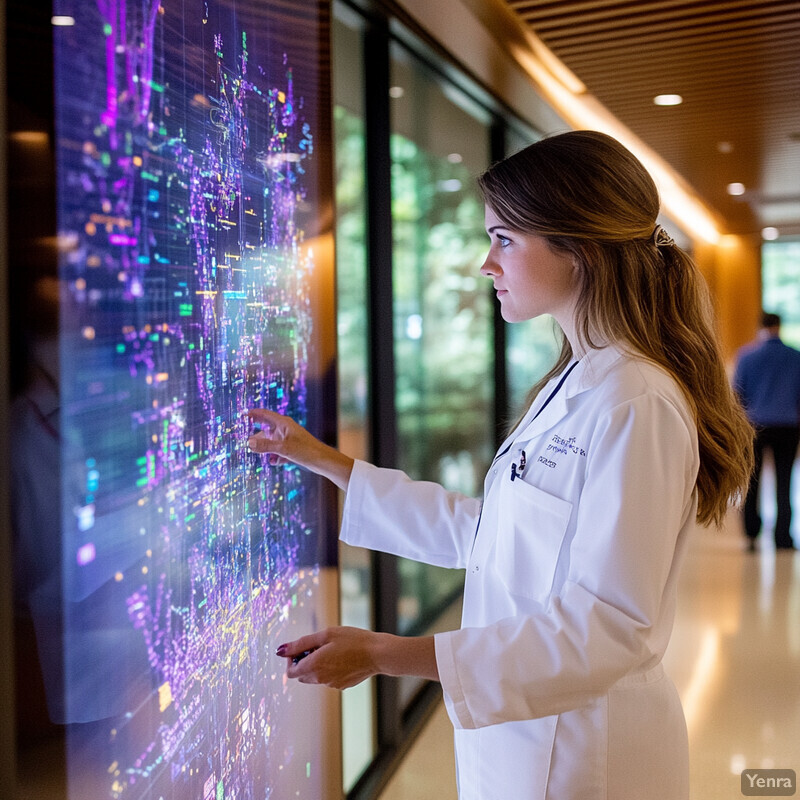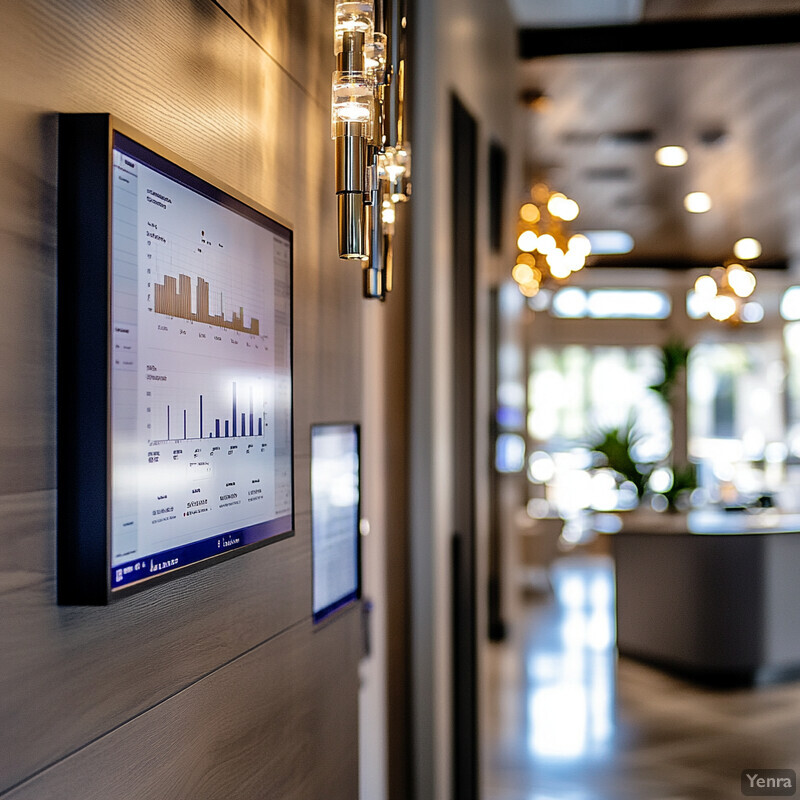1. Predictive Modeling for Risk Stratification
AI-driven predictive models analyze extensive patient data (genetics, family history, environment, etc.) to estimate an individual’s risk of developing specific allergies. By identifying high-risk patients early, clinicians can implement proactive measures – such as early testing, lifestyle adjustments, or preventative therapies – to potentially prevent allergies before they fully develop. This data-driven risk stratification enables more preventative care, targeting those most likely to benefit from early interventions.

In pediatric allergy research, machine learning has shown promising accuracy in forecasting long-term allergy outcomes. For example, one model using young children’s clinical data was able to predict persistent asthma (a common allergic condition) with up to 81% accuracy. This indicates AI can reliably stratify which children are likely to have enduring allergic disease, allowing for early preventive strategies.
2. Real-Time Environmental Allergen Tracking
AI integrates live data on pollen counts, air pollution, weather, and other environmental factors to provide real-time allergy risk assessments. By continuously analyzing these data streams, AI systems can warn allergy sufferers when local allergen levels are spiking. This enables individuals to take timely precautions – for instance, staying indoors during high pollen hours or wearing masks outside – based on up-to-the-minute conditions. Such dynamic tracking greatly improves day-to-day management for people with environmental allergies.

Advanced models can now monitor airborne allergens almost as well as a human expert. In 2023, researchers reported an AI system that was trained on thousands of pollen grain images and achieved a 96% correlation with human experts in counting and classifying different pollens. This near-human level performance means automated networks of pollen sensors and AI algorithms can reliably alert patients to surges in specific allergens in their area in real time.
3. Personalized Allergen Profiles
By examining a person’s unique genetic markers, immune responses, and lifestyle factors, AI can create a personalized allergen profile that maps exactly which substances trigger their allergies and how severely. This goes beyond generic allergy tests by synthesizing multiple data sources (DNA, blood tests, diet, environment) to pinpoint an individual’s sensitization pattern. Clinicians can use these AI-generated profiles to tailor treatment – selecting the most relevant allergen immunotherapies, avoidance strategies, or dietary changes for that patient. In essence, AI helps deliver truly precision medicine in allergy care, continuously updating each patient’s profile as new data emerge.

The power of integrating diverse data is illustrated in food allergy prediction. One study combined infants’ immunological biomarkers with clinical data and used a machine learning model to predict peanut allergy by age 5 with about 84–87% accuracy (AUC). This high accuracy, achieved by analyzing genetic and protein markers (IgE/IgG antibodies) together, demonstrates how AI can identify individual risk with great precision – forming the basis for personalized allergy profiles and early, targeted interventions.
4. Machine Learning-Assisted Diagnostic Tools
AI is augmenting traditional allergy diagnostics (like skin prick or IgE blood tests) by detecting subtle patterns that humans might miss. Machine learning algorithms can analyze complex results – cross-referencing patient history, test reactivity patterns, and big datasets of known allergy cases – to improve diagnostic accuracy. In practice, an AI-assisted tool might reduce false positives/negatives by giving the clinician a confidence score or highlighting atypical reactions. The result is more reliable diagnosis of what a patient is truly allergic to, ensuring they get the correct avoidance advice or therapy and aren’t mislabeled with allergies they don’t have.

AI-driven analysis can significantly outperform standard diagnostic methods. In one 2024 study, an AI algorithm analyzing electronic health record data diagnosed pediatric asthma (an allergy-related condition) with 92% accuracy, compared to 85% accuracy using traditional diagnostic approaches. The AI also had higher sensitivity and specificity than doctors’ usual methods. This improvement underscores how machine learning can refine diagnoses in allergy and immunology, catching cases that might be missed and reducing misdiagnoses.
5. Rapid Detection of Food Allergens in Products
AI-enhanced sensors and computer vision systems can quickly detect hidden allergenic ingredients in foods – even when they are not obvious on labels. By scanning a food item (using spectral analysis or image recognition of ingredients), an AI system can identify trace amounts of peanut, tree nuts, shellfish, or other common allergens. This empowers consumers and restaurants to avoid accidental exposures in real time. Such rapid detection technology acts as an added safety net, especially for people with severe food allergies, and could significantly reduce emergency reactions caused by unknowingly ingesting allergens.

Hidden allergens in foods are a major safety issue. In the United States, undeclared allergens are the leading cause of food recalls, accounting for about 34% of all food and beverage recalls in recent years. This statistic highlights how often allergenic ingredients end up in products unnoticed. AI-based scanners that instantly flag such allergens could dramatically cut down these incidents, protecting allergic individuals by ensuring foods are truly free of unexpected triggers.
6. Guidance for Allergen Immunotherapy
Allergen immunotherapy (like allergy shots or oral desensitization) requires years-long treatment plans that must be fine-tuned to each patient. AI systems are improving this process by analyzing how a patient responds over time and then suggesting optimal dose adjustments or scheduling changes. For example, if a patient’s symptom diary and antibody levels indicate they’re tolerating a buildup phase well, the AI might recommend a slightly faster escalation of dose; if not, it might suggest holding steady. By personalizing immunotherapy protocols through machine learning insights, doctors can increase the therapy’s effectiveness and safety – achieving tolerance with fewer side effects or dropouts.

Research shows AI can predict which patients will successfully respond to immunotherapy. In one study, a machine learning model analyzing baseline patient data was able to predict long-term tolerance (sustained unresponsiveness) to milk oral immunotherapy with 87% accuracy. This means the algorithm could identify which patients were likely to become desensitized to the allergen. Using such insights, clinicians can tailor immunotherapy – for instance, proceeding more aggressively in likely responders and more cautiously in others – to maximize each patient’s chance of allergy relief.
7. Advanced Symptom Prediction and Warning Systems
Wearable health devices (smartwatches, smart inhalers, biosensors) continuously collect physiological data like heart rate, breathing patterns, and skin metrics. AI algorithms crunch these data in real time to detect the earliest signals that an allergic reaction or asthma attack is starting – often before the patient feels symptoms. By recognizing subtle trends (e.g. a slight drop in peak airflow or a jump in heart rate variability), the system can issue an alert on the patient’s phone or watch. This advance warning gives individuals crucial minutes or hours to take preventive action, such as using medication or leaving a high-allergen environment. Overall, AI-powered early warning systems help patients stay one step ahead of severe allergy and asthma episodes.

Early prediction of asthma exacerbations using connected devices is already feasible. A recent machine learning model that analyzed data from “smart” inhalers and wearables could predict an asthma attack five days in advance with an area-under-curve of about 0.83, indicating strong predictive power. In practice, such a system would translate to a clear alert well ahead of an asthma flare-up. For allergy sufferers, similar AI models using wearable sensor inputs could significantly reduce emergency events by prompting preemptive measures before full-blown symptoms hit.
8. Drug Allergy Identification
Many drug allergies are documented only in scattered doctor’s notes or are misreported by patients. AI, especially natural language processing, can comb through electronic health records (EHRs) – clinic notes, prescription histories, hospital reports – to uncover patterns of suspected drug allergies. For example, if multiple notes mention rash with a certain antibiotic, an AI can flag that as a likely allergy. Additionally, AI can cross-reference known drug structures to predict potential cross-reactions (like a penicillin allergy implying a risk with related antibiotics). By systematically identifying drug allergies, AI helps prevent dangerous prescriptions (e.g. giving a drug to someone who is allergic) and ensures patient records accurately reflect true allergies rather than outdated or erroneous labels.

Drug allergies are often over-reported and under-confirmed. A classic example is penicillin: Roughly 10% of patients in the U.S. say they are allergic to penicillin, yet over 90% of those patients are not truly allergic upon formal testing. This discrepancy arises from misinterpreted symptoms or outdated information in records. AI algorithms reviewing health records can help reconcile these gaps – confirming genuine allergy indicators and prompting reevaluation of “allergies” that likely no longer exist. This leads to safer, more appropriate medication use (so patients don’t avoid drugs they actually can tolerate, or vice versa).
9. Allergen Avoidance Recommendations
Beyond medications, managing allergies day-to-day often means adjusting one’s environment and habits to minimize exposure. AI-based recommendation engines can act like a personal allergist coach, suggesting lifestyle changes tailored to each person’s sensitivities and routine. For example, an AI might analyze local pollen forecasts and a user’s exercise schedule to recommend running in the evening instead of the morning (if morning pollen is high), or advise a specific air purifier for someone in a home with dust mite issues. By fusing personal data (where you live, your known triggers, daily schedule) with environmental data, these AI systems deliver actionable tips – from when to close windows to which travel routes have less smog – that help allergic individuals avoid triggers and thus reduce symptoms.

The need for personalized avoidance guidance is large, given how many people suffer from allergies. In the United States, allergic rhinitis (hay fever) alone affects an estimated 30–60 million people – roughly 10–30% of adults and up to 40% of children. Each person’s triggers and local conditions differ, which is why one-size advice (like “stay indoors in spring”) is often insufficient. AI can leverage big data to fine-tune avoidance strategies for each individual. For instance, identifying that a specific neighborhood has mold spore counts twice as high as another can lead to a recommendation for an allergic patient to run errands in the lower-risk area.
10. Virtual Allergen Coaches and Chatbots
AI-powered chatbots serve as virtual allergy coaches, available 24/7 to answer patient questions and provide guidance. These conversational agents (accessible via phone or computer) can educate patients on everything from how to use an EpiPen correctly to whether today’s pollen count warrants extra medication. They use natural language processing to understand patient queries (e.g. “Why am I sneezing at night?”) and respond with relevant, personalized advice, often pulling from vast medical databases. During allergic flare-ups, a chatbot can walk a patient through immediate steps to take, and for general management, it can offer tips and reminders. While not a replacement for doctors, these AI coaches fill the gap between appointments, reinforcing education and self-management so that patients feel supported in real time.

Early studies show high patient acceptance of health chatbots for chronic conditions like asthma and allergies. In one trial, an asthma-management chatbot led to an 8% improvement in patients’ asthma control test scores and was rated as helpful by 80% of users. The majority of participants found the chatbot’s advice useful and felt comfortable with its privacy safeguards. Such outcomes suggest that allergy patients, similarly, can benefit from virtual assistant support – improving adherence to treatment and confidence in handling symptoms with the constant, on-demand coaching that AI chatbots provide.
11. Predicting Cross-Reactivity Between Allergens
Some people allergic to one substance will react to chemically similar substances (cross-reactivity). AI can analyze the molecular structures of allergens (from pollen, foods, latex, etc.) to predict these hidden connections. For instance, machine learning models can scan protein databases to find that a birch pollen protein has a very similar shape to a protein in apples – explaining why birch-allergic individuals often get itchy mouths with apple (oral allergy syndrome). By mapping such relationships, AI tools help allergists counsel patients on unexpected risks (e.g. a dust mite–allergic person might react to shellfish due to shared proteins). This foresight prevents “mystery” allergic reactions and guides patients to avoid entire allergen families if necessary. It also informs the design of comprehensive allergy tests that check for all likely cross-reactants.

Cross-reactivity is common – a well-known example is the latex-fruit syndrome. Approximately 30% to 50% of people with a natural latex allergy also show allergic reactions to certain fruits like banana, avocado, and chestnut. The overlap is due to proteins in latex that mimic those in the fruits. AI-driven analysis can catalogue these protein similarities across many allergens. In doing so, it gives a statistical risk estimate for cross-reactions (e.g. predicting a high likelihood that a latex-allergic patient will react to kiwi). Clinically, this means more comprehensive advice: doctors can preemptively warn patients about related allergens rather than discovering cross-reactions only after a patient has an unexpected serious reaction.
12. Integration of Genomic and Proteomic Data
Modern allergy research generates massive genomic and proteomic datasets – from gene variants linked to asthma to the structures of allergenic proteins in foods. AI excels at sifting through this complex biological data to identify new biomarkers and therapeutic targets. For example, machine learning can find a pattern of ten gene mutations that together strongly predict eczema risk, or highlight a specific protein fragment that triggers peanut allergy. These discoveries can lead to new diagnostic tests (like a genetic screen for allergy predisposition) or even new treatments (drugs that target a protein critical to the allergic response). In short, AI helps researchers make sense of “Big Data” in biology, uncovering the molecular underpinnings of allergic diseases that would be impossible to see with conventional analysis.

The impact of AI in molecular allergy science is evident in allergen identification. A recent AI tool called ALLERDET was able to examine protein sequences and distinguish allergenic proteins from non-allergens with 97% accuracy. In practical terms, this means if a new genetically modified food or a novel drug is developed, the AI can predict with high confidence whether it might cause allergic reactions by comparing its proteins to known allergen profiles. This level of precision in analyzing proteomic data not only aids risk assessment for new products but also deepens our understanding of what molecular features make a substance allergenic – knowledge that could drive the engineering of hypoallergenic foods and treatments.
13. Enhanced Biostatistical Analysis of Clinical Trials
Allergy treatments (like new biologic drugs or immunotherapies) are tested in clinical trials that produce mountains of data. AI and machine learning are supercharging the analysis of these trials by finding patterns and subgroups that standard statistics might miss. For example, AI might reveal that a new asthma drug works exceptionally well in patients with a certain genetic profile, but not others – information that can be used to refine prescribing guidelines. Similarly, AI can simulate different trial designs or predict outcomes, helping researchers optimize trials (choosing the right endpoints, the right patient mix, etc.) to demonstrate a treatment’s benefit more clearly. Ultimately, this means promising allergy therapies can be identified and approved faster, and doctors will know which specific patient populations stand to benefit the most from a given treatment.

An illustration of AI’s value in treatment stratification comes from asthma therapeutics. Researchers applied machine learning to past trial data for the drug omalizumab (an anti-IgE antibody used in allergic asthma) and found they could predict which patients would respond to the drug with about 77% accuracy. This kind of analysis pinpoints responder vs. non-responder profiles within a trial population. In practice, such insights can save costs and time – future trials can enrich enrollment with likely responders, and clinicians can target use of expensive biologics to those patients who have the highest probability of benefit, improving overall outcomes and avoiding unnecessary treatments for non-responders.
14. Precision Medicine for Pediatric Allergies
Children’s immune systems change rapidly as they grow, and not all kids follow the same allergy trajectory – some outgrow allergies, others develop new ones. AI models are being used to track and predict these trajectories, enabling precision medicine in pediatric allergy care. By analyzing factors like a child’s growth, diet introductions, and early allergen exposures, AI can forecast whether, for instance, a toddler’s egg allergy is likely to resolve by school age or persist, or whether a wheezing infant will develop asthma. Armed with these predictions, pediatricians can personalize strategies: children predicted to outgrow an allergy might avoid over-treatment, while those likely to have enduring allergies can be targeted for early interventions (such as tolerance induction efforts). This foresight helps guide feeding decisions, timing of immunotherapy, and parental counseling with an eye toward the child’s long-term allergy outlook.

Allergies in children are indeed dynamic. A 2023 study presented at the AAAAI meeting found that roughly 25% of children with IgE-mediated food allergies eventually outgrew at least one of their food allergies over time. (The same study noted a similar one-quarter rate of outgrowing in adults with food allergies, indicating many allergies are not lifelong.) This reinforces how important it is to identify which allergies are likely temporary. AI can improve on broad statistics by giving individualized predictions – for example, flagging a child as having a high chance of outgrowing a milk allergy by adolescence versus another child who has only a slim chance of outgrowing their peanut allergy. Such information allows for more nuanced, child-specific allergy management plans.
15. Continuous Quality Improvement in Clinics
Allergy clinics generate data on every patient encounter – diagnoses made, treatments given, outcomes, and even patient feedback. AI-driven analytics can continuously crunch these data across the practice to uncover areas for improvement. For example, AI might find that certain allergy tests in the clinic have a higher false-positive rate, suggesting a need to change protocols, or that patients with a specific profile aren’t responding well to standard therapy, indicating a training gap or need for protocol adjustment. Additionally, AI can monitor adherence to clinical guidelines (are all asthma patients getting spirometry? are anaphylaxis patients prescribed epinephrine auto-injectors?) and flag inconsistencies. By providing this feedback loop, AI helps allergists refine their practice – standardizing care, reducing errors, and improving patient outcomes. It effectively turns everyday clinical data into lessons for evidence-based improvements.

Data audits have revealed gaps that AI can help address. In one analysis of primary care asthma management, an AI text-mining of medical notes found that clinicians’ adherence to asthma treatment guidelines was low in many cases. This kind of finding is critical – poor guideline adherence can lead to suboptimal patient care. AI tools can not only identify such deficiencies across a clinic or health system, but also track improvements over time as providers adjust. In allergy clinics, implementing an AI-driven quality dashboard could, for instance, increase the rate of proper anaphylaxis emergency planning or ensure more consistent counseling for immunotherapy, directly boosting the standard of care.
16. Allergy Management Apps with Predictive Features
Smartphone apps for allergy sufferers now go beyond simple symptom logging – many incorporate AI to predict risk and coach patients. These apps might combine a user’s symptom trends with external data (weather, pollution, pollen forecasts) to forecast how bad tomorrow’s allergies might be and suggest preemptive actions (like taking an antihistamine tonight). They also can track medication usage and send personalized reminders or tips (for example, reminding someone to take nasal spray before peak pollen hours, based on the app’s predictions). By acting as an intelligent companion, allergy apps help patients adhere to treatment plans and adjust daily behaviors in advance of flare-ups. The convenience and real-time feedback via a device that patients carry everywhere result in better self-management and potentially fewer doctor visits or sick days.

Mobile health (mHealth) interventions have demonstrable benefits for allergy and asthma control. A comprehensive 2022 review noted that asthma patients using app-based monitoring had better disease control, and importantly, that simple app features like push notification reminders can double medication adherence rates. Increased adherence and timely medication use translate to fewer symptoms and emergencies. Many allergy apps leverage notifications and AI predictions similarly – for instance, alerting a hay fever patient when high pollen is forecast and doubling the likelihood they use their prophylactic nasal spray. Such predictive coaching has been shown to improve day-to-day symptom scores in clinical studies, validating the role of AI-enhanced apps in allergy care.
17. Remote Patient Monitoring and Intervention
Internet-of-Things (IoT) devices in homes – smart air purifiers, HVAC systems, humidity sensors, etc. – can be orchestrated by AI to maintain an allergen-safe environment automatically. For example, if indoor sensors detect a rise in pollen or particulate matter, an AI system could turn on air filtration and adjust ventilation settings before the levels become bothersome. It can also alert patients about indoor conditions (like mold-prone humidity levels) and even dispense interventions (some advanced systems might release a mist to reduce dust). By continuously learning a home’s patterns, AI can optimize these interventions (perhaps pre-cooling and filtering the air at 5 AM if it predicts that’ll reduce morning pollen influx). This kind of hands-free environmental control greatly reduces exposure inside “safe zones” like one’s home. It’s especially beneficial for severe allergy or asthma patients, providing round-the-clock protection without the patient having to manually manage their environment.

Environmental control devices are effective – and AI can make them smarter. Studies show that high-efficiency particulate air (HEPA) filters, for instance, can remove roughly 43%–73% of airborne allergens and particulate matter from indoor air in controlled trials. Using AI, the activation of such filters can be timed and targeted for maximum effect (for example, ramping up filtration when outdoor allergen counts peak or when cooking might release irritants). Consistent use of these tools has tangible results: clinical research has linked improved indoor air quality to better respiratory health and fewer allergy symptoms. AI’s role is to ensure those improvements are continuous and adaptive, efficiently keeping homes within safe allergen thresholds.
18. Early Intervention in High-Risk Populations
Allergic diseases often hit certain communities harder – due to factors like pollution, housing quality, and limited healthcare access. AI can analyze socioeconomic and public health data to flag communities at high risk for allergies and asthma. For example, by mapping ER visits for asthma, air quality readings, and income levels, AI might identify specific urban neighborhoods where children have unusually high asthma rates. Public health officials can use these insights to target interventions: organizing free allergy screenings and education in those neighborhoods, improving air filtration in schools there, or focusing pest control to reduce cockroach allergens in public housing. In essence, AI helps allocate resources more effectively by spotlighting the where and who of allergy disparities. This leads to earlier, community-level actions – preventing allergic diseases or treating them sooner in populations that historically suffer worse outcomes.

Disparities in allergy and asthma are well-documented. For instance, U.S. CDC data show that Black children have roughly double the asthma prevalence of white children (about 10.9% vs 5.1%, respectively, with current asthma). Likewise, lower-income urban populations tend to have higher rates of conditions like asthma and allergic eczema than higher-income or rural populations. AI-driven analysis can combine such demographic data with environmental factors (like inner-city pollution or allergen exposure indices) to predict where allergies will be most severe. By 2025, health departments in some cities are using predictive models to deploy air quality interventions and community health workers to the precise areas where asthma hospitalizations are forecast to spike, exemplifying data-driven early intervention to reduce inequality in allergy outcomes.
19. Adaptive Allergen Desensitization Strategies
Traditional allergen desensitization (whether via oral immunotherapy for foods or allergy shots for pollen) follows a mostly fixed schedule of gradually increasing doses. AI offers a way to adapt these protocols in real time to a patient’s responses. If a patient is reacting too strongly, the AI might suggest a slower dose escalation; if they’re handling it well, perhaps it recommends a faster pace or a higher final dose to achieve tolerance. The AI does this by continuously learning from the patient’s feedback (symptoms, lab results) and from large datasets of other patients’ desensitization courses. An adaptive strategy means each patient’s therapy is uniquely calibrated – reducing the chance of serious reactions during treatment and improving the likelihood they can reach a maintenance dose and stay on therapy. This personalized pacing is especially valuable in food allergy OIT, where dropout rates due to side effects can be high.

One of the challenges in desensitization therapy is patient dropout due to adverse reactions. A review of oral immunotherapy (OIT) trials found that on average about 10–20% of patients discontinue OIT, and some studies report up to one-third of patients cannot complete therapy. The main reasons are allergic reactions or the burden of treatment. Adaptive AI-guided dosing could help lower these dropout rates by keeping exposure at just the right level the patient can tolerate. In concept, if AI can even halve the dropout rate (say from 20% to 10%), that means significantly more patients achieving protection. Preliminary implementations of algorithm-guided peanut OIT in research settings have shown fewer severe reactions, suggesting that this personalized approach can indeed make desensitization safer and more effective, thereby improving overall success rates of these treatments.
20. Data-Driven Policy and Public Health Recommendations
AI doesn’t just help individual patients – it also analyzes population-level data to guide public health policy on allergies. By examining trends in climate data, pollution, allergen distribution, and allergy prevalence, AI can inform decisions like where to allocate funding or how to update regulations. For example, if AI finds that longer pollen seasons (due to climate change) are leading to more asthma attacks nationwide, policymakers might strengthen air quality regulations or invest in urban greening projects that plant low-allergen trees. Similarly, AI could reveal emerging allergy threats (such as a new invasive plant spreading potent pollen), prompting early mitigation efforts. In the food industry, analyzing patterns of anaphylaxis could support stricter labeling laws or allergen controls. In sum, AI turns countless data points into actionable insights for laws, guidelines, and resources that protect the community at large from allergy risks.

Environmental shifts are already affecting allergies, and big data confirms it. A 2021 analysis of long-term North American data found that pollen concentrations have increased by over 21% in the past three decades and pollen seasons have lengthened by about 20 days, largely attributable to climate change. Insights like these (unearthed by data analysis across hundreds of stations) are spurring public health responses – for instance, cities developing early warning systems for high-pollen days and policymakers considering climate adaptation measures to curb allergen exposure. Likewise, large-scale data on food allergies have led to policies such as adding sesame as an officially regulated allergen in the U.S. in 2023. These examples underscore how data-driven understanding of allergy trends directly translates into community-wide protections and informed policy decisions.